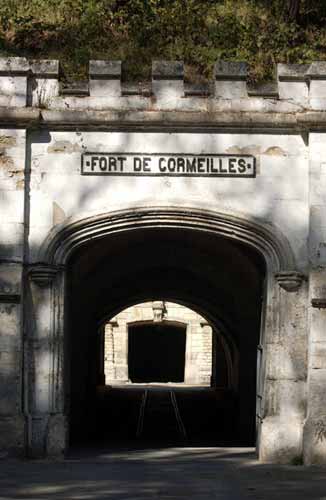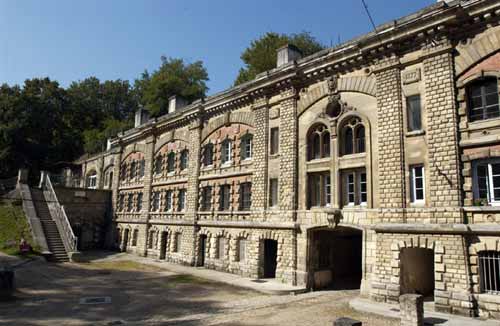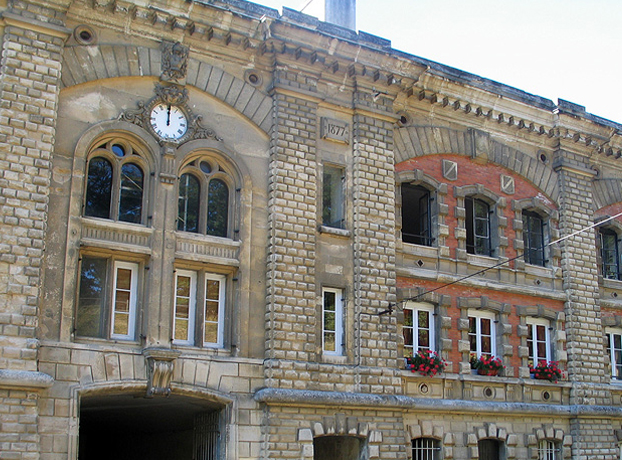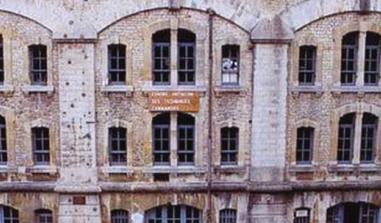The fort of Cormeilles

Façade of the fort of Cormeilles. ©Jean-Noël Lafargue
1870 - Fort of Cormeilles is considered as a priority. Its mission is, on one hand, to block the peninsula of Argenteuil, market gardening zone, essential for a new eventual siege of Paris.
After the defeat by Germany in the war of 1870, France will loose Alsace and a part of Lorraine. Furthermore it is condemned to pay a war indemnity of five billion gold-francs and hasn't got the right to defend on the Eastern borders anymore. The technological progress achieved by the artillery since 1858 (loading with cylinder heads and the use of striped canons) considerably increased its range and precision: the existing fortifications, including those of Paris, are now completely obsolete.
The government of Adolphe Thiers react vigorously to this situation and charges General Raymond Séré de Rivière to draw up a report on the defence of France. The new Parisian defence plan includes the construction of a defence enclosure of 43 works, which measure six to seven kilometres of distance from the original enclosure of 1841.
The envisaged budget equals to 400 million gold pieces and will exceeded of 33 million!
Since in 1870 the Prussians used the Parisis Hillock as observatory and artillery position, the fort of Cormeilles is considered as a priority. Its mission is, on one hand, to block the peninsula of Argenteuil, market gardening zone, essential for a new eventual siege of Paris. On the other hand the fort of Cormeilles is used to protect the road, as well as the railway access to the Montmorency valley towards Pontoise and Rouen in crossing the shootings with the fort Monlignon.
It was built between 1874 and 1878, for a total cost of 3,3 million gold. This price includes the purchase of the grounds and the construction work of a public company, controlled by the civil engineering.
The fort has the shape of an irregular trapezoid, whose 1,2 kilometres long ditch consists of three clay kaponiers. This fort of first generation (central massive building and high levelled battery), possesses two fronts turned towards the attacker and two flanks turned towards Paris, in order to save in terms of earthworks and to ease an eventual re-conquering of the fort. Originally a grid, followed of a clay pit by two fusillade crenels, protected the entrance of the fort. Nowadays this pit is filled. A gantry makes the crossing of the obstacle possible, by being retracted on the left with the use of a winch.
A central massive building, protecting the officer's building, includes 7 cellars for canons and sheltering mortars intended to beat the slopes of the Hillock. Here the artillery peak wasn't possible to see. The garrison of the ford included 36 officers, more than a thousand men and 24 artillery horses. This fort being one of the first built among the defence enclosure of the Séré de Rivère program, serves as testimony and its plans are diffused among the engineers as an example.
From 1855 it is however out of date because of the shell-torpedo crises. The engineers modify many of the Séré de Rivière forts. The fort of Cormeilles will not profit from any modernization program.
During the first world conflict it is used as deposit and also as anti-aircraft battery against the zeppelins that came to bombard Paris.
During the short campaign of 1940, the artillery pieces of the fort open fire and shoot down several enemy planes. The Germans occupy the building and use it as ammunition deposit for the Kriegesmarine. From now on they shelter anti-aircraft batteries of 20 mm Flack instead of the old 75 mm guns.
Released by the FFI of the region the fort is then used as a prison to lock up the war prisoners, the collaborationists and the traffickers of the black market. The last officer leaves this place in 1955 and the prison will be closed in 1956. In 1967 the fort is assigned to the 23rd infantry regiment of the Navy and accommodates an initiation centre of the commando which will function permanently, in particular also for many reserve units, until the dissolution of this regiment, at the beginning of the 80's. Given up from the Ministry of defence to the Ile-de-France region, the fort is today managed by the association "Friends of the Cormeilles fort" (l'association des amis du fort de Cormeilles), which is at present looking for objects and documents relating to the work, in order to enrich the collection and build a military museum at the heart of the fort.
Le fort de Cormeilles
Contact : Les amis du fort de Cormeilles
1, Route stratégique 95240 Cormeilles-en-Parisis
Tél. 06.80.92.48.57
E-mail : jean-pierre.mazier@wanadoo.fr
Visits The association Friends of the Cormeilles fort organizes each first Sunday
at 3 p.m. of the month guided tours of the fort. Access to Cormeilles-en-parisis
By car : 40 km from Paris. Take the A 115 in direction to Cergy-Ponyoise via Franconville
(exit n°2 Ermont-Cernay, Franconville, Sannois).
By train (RER) : SNCF railway station of Cormeilles
is connected during the rush hours by a shuttle service to the RER (A) station of
Sartrouville and to the RER (C) station of Montigny-Beauchamps during the whole day.
By train : 15 min from the Saint-Lazare station, direction Pontoise or Mantes-la-Jolie.

Entrance of the fort of Cormeilles. Copyright : ECPAD

Façade of the fort of Cormeilles

Façade of the fort of Cormeilles. ©Jean-Noël Lafargue
Practical information
1, Route stratégique 95240
Cormeilles-en-Parisis
Tél. 06.80.92.48.57
Visites guidées de l'ouvrage chaque premier dimanche du mois à quinze heures.




